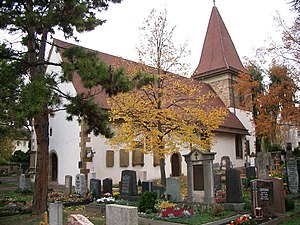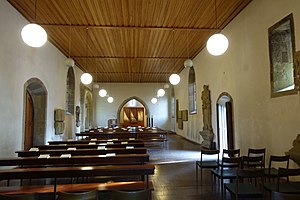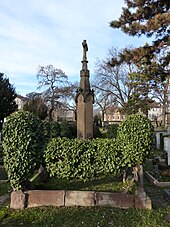Uff churchyard
The Uff-Kirchhof in Stuttgart - Bad Cannstatt was built in the 8th or 9th century at the intersection of a Roman road and is one of the oldest cemeteries in Stuttgart.
The cemetery is located in the Seelberg district in the Stuttgart-Bad Cannstatt district. The name Uff-Kirchhof goes back to the lost hamlet of Uffkirchen ("Auf der Kirchen"). The cemetery area covers around 1.5 hectares and is divided into sections 1–14 with around 2,300 graves.
On the cemetery area there is a kiosk, a morgue, the listed, late Gothic Uffkirche , which is used as a cemetery chapel, and a war memorial for those who died in the Franco-German War .
history
Since 1506 the churchyard was the burial place for Cannstatt on the right side of the Neckar, because no more burials were carried out in the area of the Cannstatter Stadtkirche due to the damp soil. In 1914 the Uff-Kirchhof became the property of the political municipality of Stuttgart as part of the division of the Cannstatt Civic Foundation.
In the vicinity of the cemetery are the Evangelical Luther Church, completed in 1900, the Catholic Church of Our Lady, completed in 1909, and the Ganzhorn complex, which was created when the Church of Our Lady was built in 1907. The green area was named after Wilhelm Ganzhorn , whose grave is in the Uff churchyard. He became famous as the poet of the popular song " In the most beautiful meadow ".
Uff Church
The Uffkirche consists of a 23-meter-long and 10-meter-wide nave with a gable roof, the massive, approximately 27-meter-high choir tower rises in the east on a square base with a side length of 5 meters and ends with a pyramid roof. The late Gothic Uffkirche “To our dear women”, whose “simple, unadorned overall impression is more reminiscent of a Romanesque village church than of Gothic architecture”, was built according to an inscription above the south gate in 1494, using the Romanesque and early Gothic core of a previous church . In 1881/1882 the tower was extended to the north by a low extension. The church was badly damaged in World War II and has been used as a cemetery chapel since its post-war restoration.
Pointed-arched tracery windows on the tower and nave point to the late Gothic construction period of the church. The outer walls are plastered white, corners, windows, doors and the upper floor of the tower are made of natural stone. 8 outer epitaphs are attached to the facades . In the interior, a pillar-less hall with a flat wooden ceiling, there are 6 interior epitaphs on the walls, and the remains of 2 tombs made of 3 to 4 stone slabs can be found on the walls, which were transferred to the church when the cemetery walls were renewed . On the north wall there is an empty, wide altar niche with a round arch and roof that reaches almost to the ceiling. A partition with a pointed arched portal separates the nave from the choir of the east tower, in which the organ is built.
War memorial
The war memorial near the Uffkirche in section 10 of the cemetery is “dedicated to the memory of the brave warriors from the campaign of 1870–1871”, as the gilded inscription says. A high column made of yellow sandstone with a hexagonal cross-section rises above a narrow base and is hidden behind thick ivy hedges. The 6 inscription fields of the column are decorated with trophies above the pedestal and end with a relief of an iron cross and a Gothic pointed arch with a finial. The column ends in a pyramidal roof made of gray cast stone, which is crowned by a large cross with a laurel wreath hung around it.
The inscription fields bear 6 gilded inscriptions by fallen soldiers, for example:
- “August Krüger, fusilier in the 1st Magdeb. Inf. Regt. No. 26, born Aug. 11, 1845 in Neundorf, used. Aug. 30, 1870 near Beaumont, died Sept. 18, 1870 "
Graves
| → Column legend and sorting | ||||||||||
| Legend | ||||||||||
|
||||||||||
| Sorting | ||||||||||
| image | # | P | K | dig | * | † | Artist / object |
|---|---|---|---|---|---|---|---|
 |
K | Karl Eberhard Bechstein, manufacturer. | 1883 | 1951 | NN, stone monument with large cross and jewelry. | ||
 |
12 | P | Karl Burckhardt, spa doctor. | 1818 | 1888 | ||
 |
11 | P | Gottlieb Daimler engineer, automobile designer and industrialist, inventor of the high-speed gasoline engine. | 1834 | 1900 | ||
| P | Adolf Daimler , son of Gottlieb Daimler, director and co-owner of the Daimler-Motoren-Gesellschaft . | 1871 | 1913 | ||||
 |
P | K | Hugo Denner, electrical engineer, owner of an electrical engineering workshop. | 1877 | 1949 | NN, obelisk. | |
| 08 | P | Friedrich von Dillenius , General Director of the Württemberg State Railways. | 1819 | 1884 | |||
 |
P | Frederick Robert Vere Douglas-Hamilton , engineer. | 1843 | 1917 | |||
| 04 | P | K | Ferdinand Freiligrath , freedom poet and translator. | 1810 | 1876 | Adolf von Donndorf , bust by Ferdinand Freiligrath. | |
 |
P | K | David Friedrich Fritz, architect. | 1854 | 1923 | NN, grave monument with two bronze palmette reliefs. | |
 |
08 | P | Wilhelm Ganzhorn , judge and poet (“In the most beautiful meadow area”). | 1818 | 1880 | ||
 |
13 | K | Otto Gerlach. | 1874 | 1930 | NN, stone monument with a relief of a tree with a climbing vine. | |
 |
P | K | Johann Ernst Gleißberg, dean and pastor in Bad Cannstatt . | 1793 | 1864 | NN, sandstone tomb with tracery arch. | |
 |
K | Friedrich Haaga, jeweler and manufacturer. | 1822 | 1901 | NN, stone rock with two bronze reliefs: Portrait of Friedrich Haagas and a woman caressing a fawn. | ||
 |
07 | P | Oscar Heiler , popular actor and comedian. | 1906 | 1995 | ||
 |
04 | P | Jakob von Heine , physician and discoverer of spinal polio (called Heine-Medin's disease since 1907). | 1800 | 1879 | ||
| P | Friedrich Hesser , founder of the German packaging machine industry, founder of Fr. Hesser Maschinenfabrik AG | 1831 | 1906 | ||||
 |
K | Adolf Hieber, director. | 1888 | 1943 | NN, bronze coat of arms relief. | ||
| P | Ernst Kapff , educator and archaeologist, discoverer of the Roman fort on the Hallschlag in Stuttgart (1894). | 1863 | 1944 | ||||
 |
13 | P | Emil Kiemlen , sculptor. | 1869 | 1956 | ||
| 13 | P | Heinrich Adolf Köstlin , Protestant theologian, music writer and music philosopher. | 1846 | 1907 | |||
| 13 | P | Therese Köstlin, religious poet. | 1877 | 1964 | |||
| 08 | P | Augustin Krämer , marine doctor, anthropologist and ethnologist, 1911–1915 first director of the Linden Museum in Stuttgart . | 1865 | 1941 | |||
 |
08 | P | Hermann Lang , racing car driver. | 1909 | 1987 | NN, relief of a racing car. | |
| K | Richard Leuze. | 1852 | 1898 | NN, nice tombstone. | |||
| 08 | P | Sigmund Lindauer , corset manufacturer. | 1862 | 1935 | |||
 |
14th | P | Wilhelm Maybach , engineer and automobile designer. | 1846 | 1929 | ||
 |
P | K | Virgil Mayer, founded the Homeopathic Central Pharmacy Bad Cannstatt in 1857 . | 1834 | 1889 | NN, obelisk. | |
 |
P | Ernst Alois von Meisrimmel , Major General of Württemberg. | 1786 | 1853 | |||
 |
14th | P | Bernhard Molique , violinist and composer. | 1802 | 1869 | ||
 |
P | Hermann Pantlen , Army Archives Director . | 1887 | 1968 | |||
 |
13 | K | Robert Pfisterer. | 1904 | 1987 | NN, stone monument with bronze portrait reliefs by Johanna and Robert Pfisterer. | |
 |
P | Otto Riethmüller , theologian. | 1889 | 1938 | |||
| 14th | P | Heinrich Albert Schächterle, designer, inventor of standardization. | 1887 | 1917 | |||
 |
K | Wilhelm Schaff. | 1853 | 1915 | NN, bronze coat of arms relief. | ||
 |
K | Johann Georg Schempp, foreman. | 1813 | 1881 | NN, sandstone tomb with jewelry. | ||
 |
K | Gustav Schnürle. | 1861 | 1931 | NN, high relief with crucifixion group . | ||
| P | Adolf von Seubert , military and art writer. | 1819 | 1880 | ||||
 |
P | K | Wilhelm Speidel, Dr. Ing., Senior building officer, monument conservationist and co-founder of the Stuttgart City Lapidarium . | 1887 | 1956 | NN, stone relief with a Greek cross in a wreath of leaves. | |
 |
11 | P | Michael Streicher , founder of M. Streicher, iron u. Steel foundry, steam boiler factory, vehicle construction. | 1836 | 1890 | ||
| 14th | P | Charles Terrot , manufacturer of circular knitting machines. | 1831 | 1903 | |||
 |
P | K | Erich Traub , veterinarian and researcher into the means of biological warfare. | 1906 | 1985 | ||
 |
04 | P | Albert von Veiel , doctor and dermatologist, founder of Germany's first skin clinic on Wilhelmsplatz in Bad Cannstatt . | 1806 | 1874 | ||
 |
P | K | Gustav Vischer , head of the Daimler-Motoren-Gesellschaft (1892–1910), founding member and first chairman of the VDMI . | 1846 | 1920 | NN, stone heraldic relief. | |
 |
04 | P | Ludwig Walesrode , journalist. | 1810 | 1889 | ||
| P | Karl Weber, architect. | 1865 | 1909 | ||||
 |
K | Carl Friedrich Weisser, master watchmaker. | 1842 | 1899 | NN, grave monument with decorative ornaments. |
Epitaphs
Main article: Epitaphs of the Uff Church .
On or in the Uffkirche, 8 wall epitaphs have been preserved on the outside walls and 6 inside the church. They were built in the 17th and 18th centuries for the citizens of Cannstatt, including the mayors Jakob Speidel and Jakob Spittler. The splendid epitaph for Jakob Speidel is one of the most important Renaissance epitaphs in Württemberg. 5 epitaphs are well preserved, the others are damaged or only partially preserved.
Grempp altar
The colored wooden sculpture "Madonna with the saints of the Grempp family" in the Württemberg State Museum in Stuttgart served as an altarpiece for the family altar of the rich Württemberg family Grempp. The altar, built between 1508 and 1517, was a family foundation for the Uffkirche, in which several of her maternal ancestors were buried, and was later moved to the Württemberg State Museum in Stuttgart for conservation reasons. The altarpiece was originally marked by inscriptions and coats of arms, apparently on a cornice. The adults of the group of figures, who crowd around the enthroned Madonna with the baby Jesus, were named saints of the donors:
- At the feet of the Madonna in rear view St. Agatha, name saint of Agathe Besserer, who was married to Onuphrius Grempp since 1508.
- Left: St. Konrad and kneeling St. Cordula: namesake of Konrad Grempp and his wife Cordula, a daughter of the Stuttgart personal physician Dr. Johann Widmann.
- Right: St. Onuphrius and kneeling St. Margaretha: namesake saint of Konrad Grempp's son Onuphrius Grempp, Stuttgart Chamber Master, and his grandmother Margarethe born. Kudermann.
poetry
The Swabian poet Mathilde Leonhardt (1836–1915) created a poem about the “Uffkirchlein” at the turn of the 20th century. In a poem about the "Uffkirchhof" she sang about the cemetery and remembered the lost place Uffkirchen:
A church stands in their
circle, the organ has long since fallen silent,
its hall empty, far away the hour,
where it fills a pious song."Uffkirchen", only your cemetery reminds you of
old names, old places;
The new time that broke new way,
step over your clod .
literature
- Eva-Maria Bast; Sibylle Schwenk: Cannstatter Secrets: 50 Exciting Stories from the Sauerwasser City. Überlingen: Bast-Medien-Service, 2014, pp. 68–69 (Plattenweg to Uffkirche), 157–159 (Assumed fire in the Uffkirche).
- Hansmartin Decker-Hauff: History of the City of Stuttgart, Volume 1. Stuttgart 1966, pp. 316-317, 367 to page 317 (Grempp altar).
- Jürgen Hagel: Stuttgart Archive. Braunschweig, 1989–1996, number 01.015 (Grempp altar).
- Werner Koch; Christopher Koch: Stuttgart cemetery guide. A guide to the graves of well-known personalities. Tübingen 2012, pp. 72–85.
- Mammut-Verlag (publisher and editor): Stuttgart, Der Friedhofswegweiser. Stuttgart 2011, pp. 118–119 (available free of charge, including at the information desk in the town hall).
- Johann Daniel Georg von Memminger: Description of the upper office Canstatt. Stuttgart: Cotta, 1832, pp. 5, 22, 108, 120, 125, 127, 128, pdf .
- Eduard Paulus: The art and antiquity monuments in the Kingdom of Württemberg: Neckarkreis. Stuttgart 1889, page V, 144, 146-147, pdf .
- Uffkirchen Castle. In: Hans Schleuning (editor), Norbert Bongartz (collaboration): Stuttgart-Handbuch. Stuttgart: Theiss, 1985, p. 177.
- Martin Woerner; Gilbert Lupfer; Ute Schulz: Architectural Guide Stuttgart. Berlin: Reimer, 2006, number 265, p. 165.
- Dagmar Zimdars (editor): Baden-Württemberg I. The administrative districts of Stuttgart and Karlsruhe. In: Georg Dehio (Hrsg.): Handbook of German art monuments. Munich 1993, p. 24.
Web links
Footnotes
- ↑ #Mammut 2011 .
- ↑ #Mammut 2011 .
- ↑ # Wörner 2006 .
- ↑ # Wörner 2006 , #Zimdars 1993 .
- ↑ August Krüger, Fusilier in 1st Magdeburg Infantry Regiment number 26, born Aug. 11, 1845 in Neundorf, wounded Aug. 30, 1870 near Beaumont, died Sept. 18, 1870.
- ↑ The original gravestone, a work by Albert Güldenstein , no longer exists. It was replaced by a modern stone lying on the ground with the inscription "Bernhard Molique Hofmusikdirektor 1802–1869".
- ↑ # Decker-Hauff 1966 , #Hagel 1989 .
- ^ The German Poetry Library, Mathilde Leonhardt: Uffkirchlein .
- ^ The German Poetry Library, Mathilde Leonhardt: Uffkirchhof .
Coordinates: 48 ° 48 ′ 15.4 " N , 9 ° 13 ′ 33.7" E










